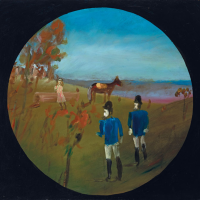67. SIDNEY NOLAN

Commissioned to produce designs for Colonel de Basils international ballet company production of Icare which would tour Australia in 1940, Sidney Nolan exposed a theatrical side of his genius, leading to further involvement with music, ballet and opera productions as his career went on.
His trait of painting en serie, as described Bryan Robertson, was indeed closely related to this aspect of his vision, a shrewd sensibility for sequencing from one image to the next, analogous to a cinematic dynamic, or the live performance of a ballet.1 And nowhere was this phenomenon better exploited than in his famous Ned Kelly series of 1946-47, nearly all painted on the kitchen table of John and Sunday Reeds house at Heide in Victoria. They were produced at breathtaking speed, one after another, enabled by the rich mercurial properties of a commercial house paint called Ripolin. As he said:
I like the immediate feeling of Ripolin and the aroma when you can see every brushstroke if you like. Some people want all surfaces to be crumbly like Stilton cheese.2
Each of the final selection of twenty-seven in this iconic series was executed on an identical sized sheet of Masonite. But more intimate, yet equally inventive, was a parallel suite of smaller scale paintings on cardboard, including Mrs Skillion Putting her Fingers to her Nose. This work is unique in its tondo format: a perfect circle, as if viewed through a telescope, or gun barrel. Its closest precedent is an oval portrait of Ned Kelly of 1946.3
Given Nolan appropriated a motif directly from the reproduction of a Camille Corot landscape in a book in the extensive art library at Heide for one of his Kelly paintings, it is tempting to think he may have also spotted a fte galante tondo or ovular format by Watteau in another publication to inspire his Mrs Skillion composition, so unusually delicate in its faux-naif disposition of figures and foliage compared to others in the suite.4
However, the gun barrel or telescope analogy makes more sense when, in the narrative, Mrs Skillion was being spied upon by a brutally oafish police force eager to find the Kelly gang and close in for the kill. The hard, metallic circle is a perfect harbinger of their fate.
Max Harris, Adelaide poet, critic, columnist, and publisher, joined the Reeds for the publication of Angry Penguins at Heide. There he met Nolan and they conspired to explore Kelly country, developing a notion that modernism would be made more palatable to Australians through a popular nationalist folk story.5
Harris intended to write an epic Kelly poem for Nolan to illustrate, but the painter had already tapped voraciously into a flood of literature during the early 1940s about the exploits of the gang and their eventual annihilation at Glenrowan in 1880, including a Royal Commission report commissioned a few months after Ned went to the gallows.
Strange things link us, because Australians are a tribe and I dont mean that in any disparaging way you see I take a sort of tribal view of our landscape and culture. I paint Kelly as part of Australias culture and mine 6
What Nolan discovered in his reading was that Mrs Skillion was Neds older sister Margaret who had married a William Skillion, falsely arrested, and imprisoned for aiding Ned during the attempted shooting of policeman Constable Fitzpatrick. This destroyed her marriage and, known for her role of quilting the armour for the gang during the final siege at the Glenrowan Hotel, she dedicated herself to supporting her brother and his gang in their efforts to remain out of reach of the law.
The police decided not to arrest her but keep surveillance hoping Margaret would lead them to the gangs hideout. She was a tough, smart woman with excellent horse-riding skill, and on many occasions, riding her horse Lightfoot, took the police on wild goose chases, leaving them exhausted. She was known to sit on a log and wait for them to catch up until, all of a sudden, she would thumb her nose at them, jump on her horse, and spur him away into the bush leaving the exasperated police in the wind.7
Mrs Skillion Putting her Fingers to her Nose is not quite as Rousseau-esque as other images of the classic series. But, based on the rectangular format of a preparatory sketch in the National Gallery of Australia, it is a deceptively clever composition. A clump of trees and foreground saplings are cropped at the left and lower edge of the circle, leading the eye to the horses head just breaking the horizon of a calm, distant terrain. It is a prime example of Nolans brilliant capacity for theatrical pause at a key moment of the narrative, conflating orthodoxy with the unorthodox, and an illusion of innocence with impending violence.
Footnotes:
1. Pearce, B. et al, Sidney Nolan, Art Gallery of New South Wales, Sydney, 2007, p.23
2. Mollison, J., Lynn, E. & Semler, C., Sidney Nolans Ned Kelly, National Gallery of Australia, Canberra, pp.9-10
3. Reeder, W. et al, The Ned Kelly Paintings: Nolan at Heide 1946-47, Museum of Modern Art at Heide, Melbourne, 1997, p.78
4. See Pearce, B. et al, op. cit., p.35 re: Corot reference, and Reeder, W. et al, op. cit., p.79, re: Mrs Skillion Putting her Fingers to her Nose
5. Harding, L. & Morgan, K., Modern Love: The Lives of John and Sunday Reed, The Miegunyah Press, Melbourne, 2015, pp.179-182
6. Mollison, j. et al, op. cit., p11
7. See Balcarek, D. & Dean, G., Ned and the Others, Glen Rowen Cobb & Co., Victoria, 1995
Barry Pearce
Barry Pearce is Emeritus Curator of Australian Art at the Art Gallery of New South Wales. He is responsible for many exhibitions and publications and is the author of Brett Whiteley: Art & Life (1995) and Sidney Nolan: Retrospective (2007).